URI’s CVSA executive board, clockwise from top: Diana Lopes, Alice Hafashimana, Leam Lima, Christian Mestre, Angelina Gomes, Paulo Mendes, Eliana Brito, and Lucas Furtado. Not pictured, Charline Reis.
Lima, a junior, says he found belonging in CVSA. “I was raised in Cape Verde and when I got to the U.S. it was hard for me to connect with people at first.” Now he sees value in teaching others about the Cape Verdean lifestyle through CVSA.
Rhode Island is home to one of the largest populations of Cape Verdean Americans in the U.S., and many have found a second home at URI. For over 30 years, the Cape Verdean Students Association has celebrated this unique culture. A strongly connected multicultural and multigenerational network, the group brings a distinctive positive impact to the URI community and beyond.
By Anna Vaccaro Gray ’12, M.S. ’16
It’s a chilly Wednesday night, but the atmosphere in URI’s Multi-cultural Student Services Center is heated. Three organizations—the Cape Verdean Students Association (CVSA), LatinX Student Association (LSA), and Student Alliance for the Welfare of Africa (SAWA)—are engaged in a fierce competition: the battle of the playlists. Nine rounds are divided into categories from moody music to party music. Each group presents a selection, hoping to win “best song” and accumulate points.
Students holler and laugh, their energy as palpable as the bass thumping through the stereo. Even the walls seem to pulsate in participation. For the last round—hype music—students from CVSA play the song “É Pa Pila” by MC Acondize. As the Cape Verdean-born hip-hop artist raps in Kriolu (Cape Verdean Creole), everyone in the room gets up to dance.
This night—people coming together to celebrate, educate, and share traditional music; where cultural pride is tangible, and differences are as joyfully revered as similarities—is a fitting snapshot of CVSA’s presence within the URI community.
Cape Verdean Students Association
Founded in 1988 by the late Antonio “Toney” DaMoura ’92 and Alex Fernandes ’92 with the mission of “promoting and illustrating the history of the rich culture of Cape Verde to the student body, faculty, and administration,” URI’s CVSA was the first of its kind in the country.
Currently run by a democratically elected group of students consisting of President Paulo Mendes, Vice President Lucas Furtado, and an executive board of six, CVSA boasts a large membership and a wide range of programming. While the association primarily serves URI’s substantial population of Cape Verdean Americans, it’s open to all students.
Mendes, a secondary education major whose parents were born in Cape Verde, is a charismatic leader. Gregarious and motivated, his enthusiasm is infectious. Furtado, a double major in computer science and French, was born in Cape Verde, moved to the U.S. when he was 17, and has a quieter demeanor. Insightful and driven, his passion for CVSA is equally apparent. Their leadership dynamic is complementary as they prioritize creating a space for Cape Verdeans to center their heritage while inviting everyone to experience the vibrant culture.
CVSA’s weekly meetings range from fun to informative—usually both at once—including game nights focused on the archipelago’s 10 islands; lessons on Kriolu, the native language derived from Portuguese and African dialects; and batuku, a traditional dance. “After every meeting we have a dance session—even when it’s not organized,” Mendes says.
CVSA also offers a variety of supports to its members. “We want to provide resources, such as how to pay term bills or find a career specialist to get an internship,” Furtado says. “We want to educate our members on everything available to them at URI.”
Their focus is partially informed by disruptions resulting from the pandemic. Among other factors, the prolonged period of canceled in-person gatherings led to shifts in student life and have necessitated a new kind of leadership.
“Their passion has been revitalizing the group,” says Kristy Embrack Searles, a marketing and event coordinator for URI’s Center for Career and Experiential Education who serves as CVSA’s advisor. “They’re finding the balance of what works between remote resources, in-person activities, and campus-wide events; and they’re making meaningful connections with the broader Cape Verdean community in Rhode Island.”
As part of such efforts, they are intentional about collaborating with other multicultural organizations on campus. “If we all work together, we all blossom,” Mendes says. In December, a Winter Wonderland event included a gingerbread house competition, cookie decorating, ornament making, and photos with Santa and was well attended by students from other groups such as LSA and SAWA.
Broader statewide initiatives are also being developed, including internships and volunteer opportunities at the Cape Verdean Museum in Pawtucket, R.I., the first museum in the country dedicated to celebrating the history and culture of Cape Verde and Cape Verdean Americans.
“We really want to give back to the community and support the whole Cape Verdean population in Rhode Island,” Mendes says.
For some members, CVSA is the one place on campus where they feel like they don’t have to explain themselves. For others, it provides cultural connection.
“I didn’t grow up speaking Kriolu,” says junior health sciences major Angelina Gomes, noting that she often felt something was missing in terms of understanding her roots. “When I came to CVSA, they said, ‘We’ll teach you.’ I finally found the place where my culture was celebrated.”
Diana Lopes, a second-year health sciences major, grew up in East Providence surrounded by Cape Verdean culture; her parents speak only Kriolu at home. She felt unmoored at URI before joining CVSA. “Being at a predominantly white institution, I felt adamant that I had to find my people,” she says. At CVSA, she felt at home.
Sophomore business major Christian Mestre says, “I want people to know about the culture and understand its impact. A lot of people don’t realize how significant Cape Verde has been to American and world history.”
While CVSA programming and events are focused on Cape Verde, Mendes notes the importance of honoring the mixture of subcultures most students experience. “It’s at the forefront of my mind to acknowledge all the cultures people are coming to the group with,” he says. “I want to make sure I learn about them and give them the spotlight at times, too.” This helps students embrace the inherent complexity of identity and find more ways to learn from each other.
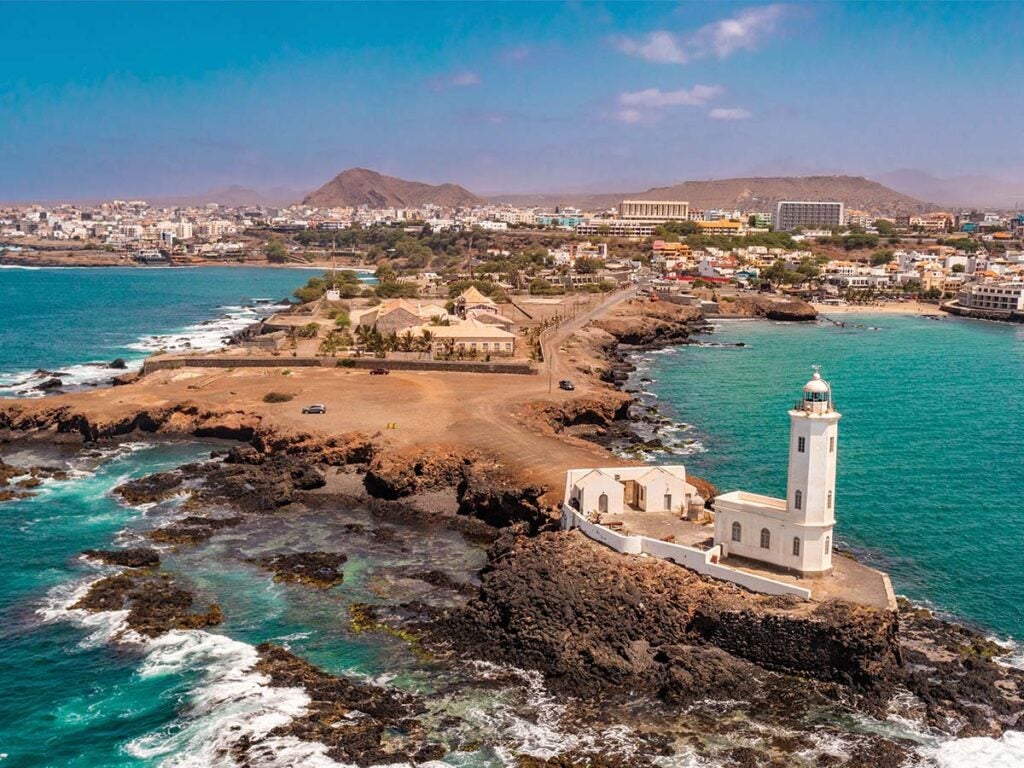
The Praia lighthouse on Cape Verde’s largest Island, Santiago.
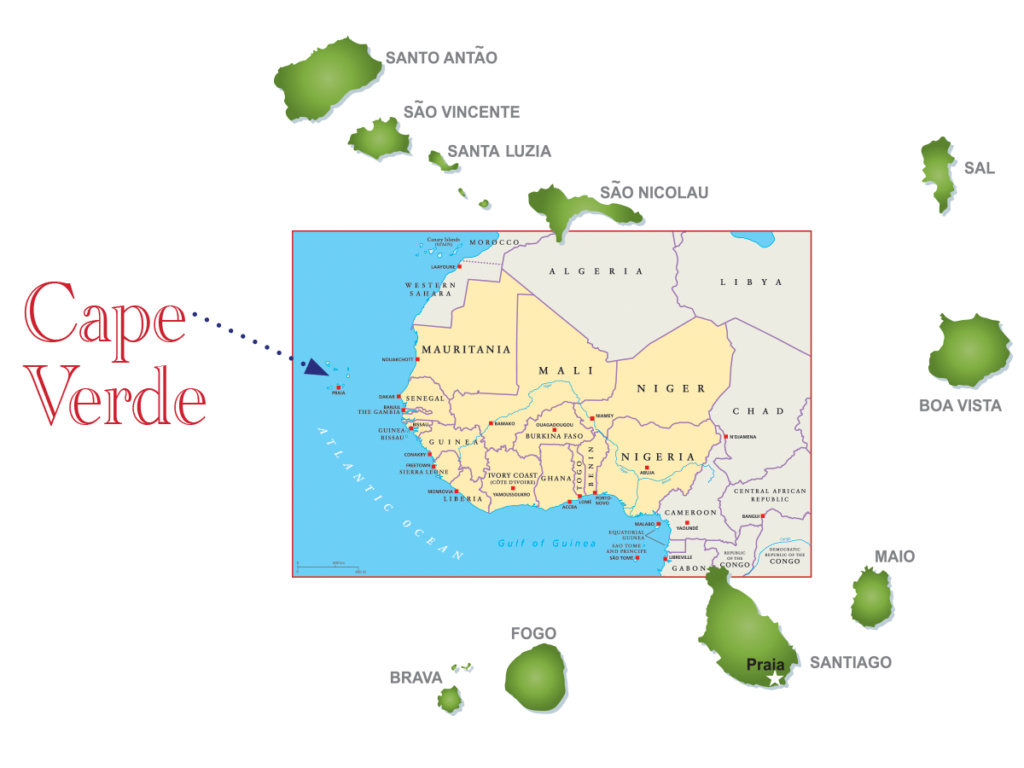
One People, Many Faces
Nestled in the Atlantic Ocean off the northwestern coast of Africa, Cape Verde is a cluster of 10 islands with a combined land area only slightly larger than the state of Rhode Island—the size being the only thing about it that is relatively unremarkable.
“Its positioning is its gift and its curse,” says Sara Monteiro ’08, co-chair of URI’s Alumni of Color Network and former member of CVSA, of how Cape Verde has proven pivotal both logistically and culturally.
Portugal claimed the uninhabited islands in 1456, and for over 300 years the archipelago was a hub for the transatlantic trade of enslaved people from all over Africa. During the Spanish and Portuguese inquisitions, it was a place of refuge for Jews and other victims of religious persecution. As commercial routes expanded, Cape Verde became a bustling trading port and coaling and resupplying stop connecting Africa, America, Brazil, and Europe.
The amalgamation of different groups coming together as one people began to shape a singular Cape Verdean ethnicity—one that is both diverse and distinctive. “Cape Verdean identity is like fruit punch, where many fruits mix together to create something delicious,” Furtado says. “Lots of little pieces from different countries come together to create one beautiful culture.”
“Cape Verdean identity is like fruit punch, where many fruits mix together to create something delicious.”Lucas Furtado, Vice President, URI Cape Verdean Students Association
Droughts beginning in the 1800s prompted Cape Verdeans to seek opportunities off the islands, and many came to New England for maritime industries. Rhode Island is now home to one of the largest populations of Cape Verdean Americans in the country (estimated to be 18,000), second only to Massachusetts.
“We were the very first Africans to arrive in the United States outside of slavery of our own accord,” says Joe DaMoura ’00, brother of CVSA founder Toney DaMoura. Joe is a former member of CVSA and is president of the Cape Verdean Museum. “Cape Verdean pride and culture have been important parts of building American culture.”
Proximity to the islands is not necessary for members of the diaspora to experience a strong relationship. Political scientist Abel Djassi Amado has researched and written extensively on Cape Verde. The former URI lecturer, currently a Simmons University faculty member, says no matter where they live, Cape Verdeans have one thing in common: longing for home. Even those born in the United States—like Mendes—echo this sentiment because of how families instill tradition through food, language, music, and dance.
“No matter how many generations removed you are from being born there, you still have that communal tie to home,” says Bobby Britto-Oliveira ’06, M.S. ’11, assistant director of URI’s Multicultural Student Services Center and co-chair of the Alumni of Color Network. An avid attendee of CVSA events in his time as a student, he has served in an administrative support role to the group since 2012. “Establishing that pride is important. It gives you the connection you don’t always have in everyday meetings and classes as a student from the African diaspora at a predominantly white institution.”
“It’s about preserving culture and not assimilating,” adds Monteiro. “Groups like CVSA are byproducts of our vision of staying true to our authentic selves.”
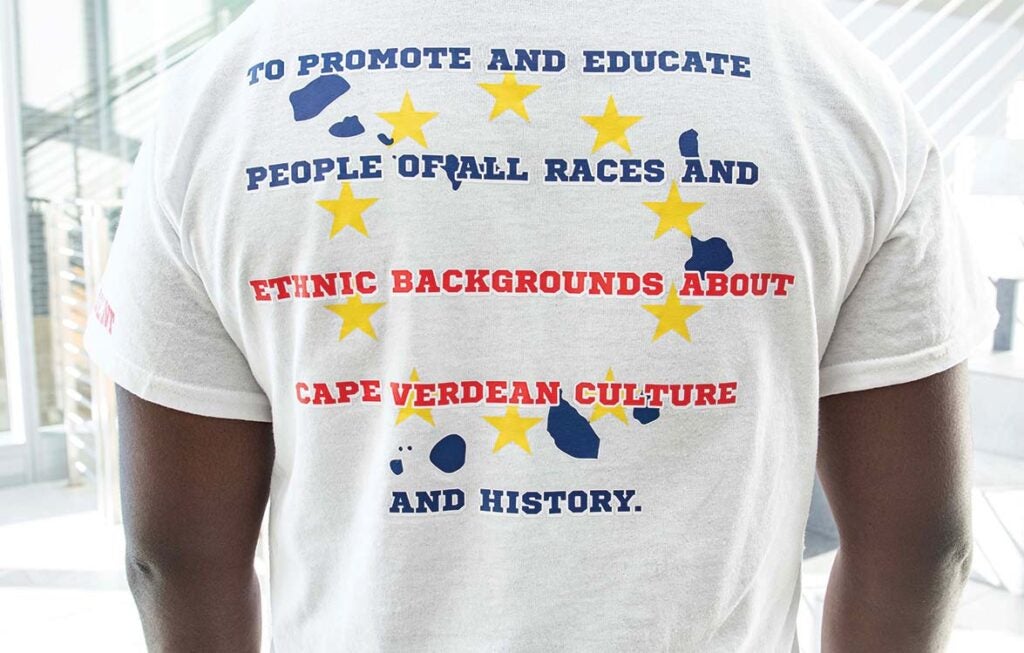
A CVSA T-shirt shows CVSA’s mission, along with the 10 Cape Verde islands and 10 stars representing the islands on the country’s flag.
“No matter how many generations removed you are from being born there, you still have that communal tie to home.”Bobby Britto-Oliveira ’06, M.S. ’11
Reach Forward, Give Back
For a student association to stand the test of time—through changes in leadership, cycles of students coming and going, and a global pandemic—is no small feat. For CVSA, its strength is in its roots.
URI’s Talent Development (TD) program was established in 1968 to recruit Rhode Island high school graduates from historically underserved groups, and it works closely with high schools that have large Cape Verdean populations. Toney and Joe DaMoura, Mendes, Furtado, and many other CVSA members came to URI through TD.
Karoline Oliveira ’94, M.S. ’03, who, as a student, was one of CVSA’s first secretaries, is now vice president of the board of directors for the Cape Verdean Museum. “TD gave us a place to explore what we wanted for ourselves, what we wanted in a classroom, and what we could do about it,” she says. “We found a community that strengthened us and empowered us to use our voices in other spaces.”
In November 1992, four years after CVSA was established, student leaders—including Malcolm Anderson ’94, Oliveira, the DaMoura brothers, and others—formed the Black Student Leadership Group (BSLG). They conducted a nonviolent takeover of Taft Hall in an effort to improve racial tensions on campus.
It was a significant moment in URI’s history and one with lasting impact. While it was not the first protest focused on the campus racial climate, it was notable in its scope.
“The students felt strongly that they were advocating even for identities they did not share,” says Searles of the 14 actionable demands that the BSLG developed and fought for through the protest. “The fact that there is now an Africana studies major; a prominent Multicultural Student Services Center; an Office of Community, Equity and Diversity—these were all seeds that were sown by the BSLG.”
These initiatives are essential for the well-being of various marginalized groups and vital components of a thriving university. The threads that weave through the BSLG’s vision, DaMoura’s mission in establishing CVSA, and the longevity of the group are reflective of what Cape Verdean culture prioritizes as a whole: the belief that community, celebration of identity, reciprocity, and diversity are strengths to be protected and cultivated.
There are many ways to measure the success of a program like TD, including how many students it brings to campus. But the power is really in the unique perspectives and contributions each student brings, enriching the URI community in immeasurable ways. Such diversity and inclusion efforts are not a zero-sum game; it is a multiplication of value that we all benefit from.
“We recognized that we may not be there to experience the results of our advocacy,” Oliveira says of the 1992 events. “But we needed to leave the University better, stronger, and more inclusive for people who came after us.”
Mendes and Furtado are two who have benefitted and continuing this cycle of reaching forward and giving back—honoring those who came before while paying it forward for future generations—shapes their vision as leaders of CVSA. “Seeing this wave of students become torchbearers to carry on this legacy is inspiring,” adds Britto-Oliveira.
A country with a singular—at times tumultuous—history creating a people who feel united despite, or perhaps because of, immense differences is a reminder that while race is a construct, ethnicity is a story. “Cape Verdeans have much to teach us about their interdependent transnational society, their community-based culture that spans borders, and the beauty in their acts of survival,” a sign in the entryway of the Cape Verdean Museum reads.
“We’re all different, but we still come together at the end of the day as one country,” Furtado says.
“We’re a glimpse into what the future could be,” DaMoura adds.
Author’s note: Cabo Verde has long been called Cape Verde in English-speaking countries. In 2013, its government requested that the official Portuguese name Cabo Verde no longer be translated between languages. Because this article focuses on the Cape Verdean Students Association, a group that was named in 1988, and individuals who use the terminology Cape Verde and Cape Verdean colloquially, we use that wording here.
Photos: Nora Lewis, iStock
A Cape Verdean Legacy
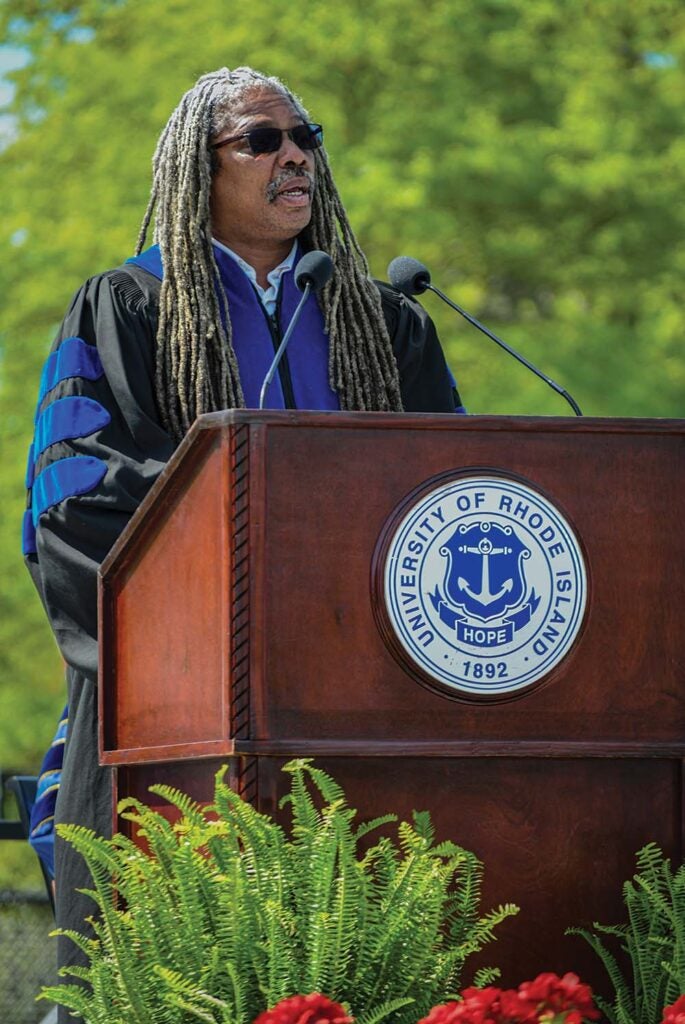
It is impossible to celebrate CVSA and URI’s vibrant Cape Verdean community without acknowledging the late Earl N. Smith III ’89, former member of both CVSA and the Black Student Leadership Group and assistant dean of the College of Arts and Sciences from 2007 until his death in 2022. A proud Cape Verdean American, he was a champion of many multicultural initiatives on campus.
Smith and Abel Djassi Amado— former lecturer at URI, now at Simmons University—developed and directed a study abroad program in Cape Verde, first taking students to the country in the summer of 2010. While there, students engaged in service-learning opportunities, visited historic sites, participated in educational sessions, and—Smith’s favorite activity—learned local fishing techniques for catching marlin and tuna. For many student participants, it was their first time visiting the homeland of their parents and ancestors.
The program has been paused since 2020 when travel was disrupted due to the pandemic. “Several parts of the university are coming together to rebuild it now, including Africana studies, Talent Development, and the study abroad program,” says Catherine John-Camara, chair of URI’s Department of Africana Studies. “It’s a need, that’s for certain.”
—Anna Vaccaro Gray ’12, M.S. ’16
Photo: Nora Lewis


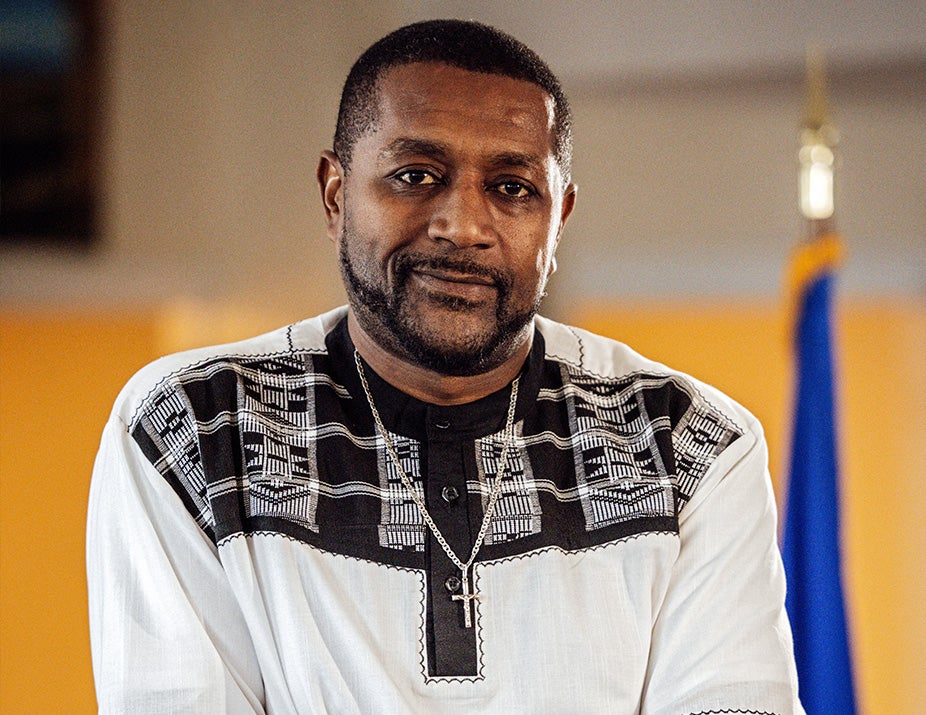
Great article. I am proud to hear the testimony of so many students that found CVSA as a vehicle to grow, understand and be proud of their culture. That was our vision (Tony and I ) when we founded this great association for all students. I’m proud and humbled. ❤️💪🏽🇨🇻
This was a wondedful article to read and was forwarded to me by my cousin Alex Fernandes who was a founding member. In 1991,I was voted Vice-President of CVSA at URI and in 1992 became President. I knew Toney and his family very well and we were great friends. Joe Damoura and his sister Maria attended URI and were members of our group during this time. And I and our group were part of the sit-in at Taft Hall that year. It brought back great memories and I was and always will be part of our CVSA family! Good luck to all past and future generations of this special and unique group of URI students.
God Bless & Nos Ku Nos!!!
Hearing all the stories of how and why CVSA started from Alex Fernandes then reading this story brings great joy to my heart seeing the vision not only fulfilled but expanded.
Thank you for a well written article.